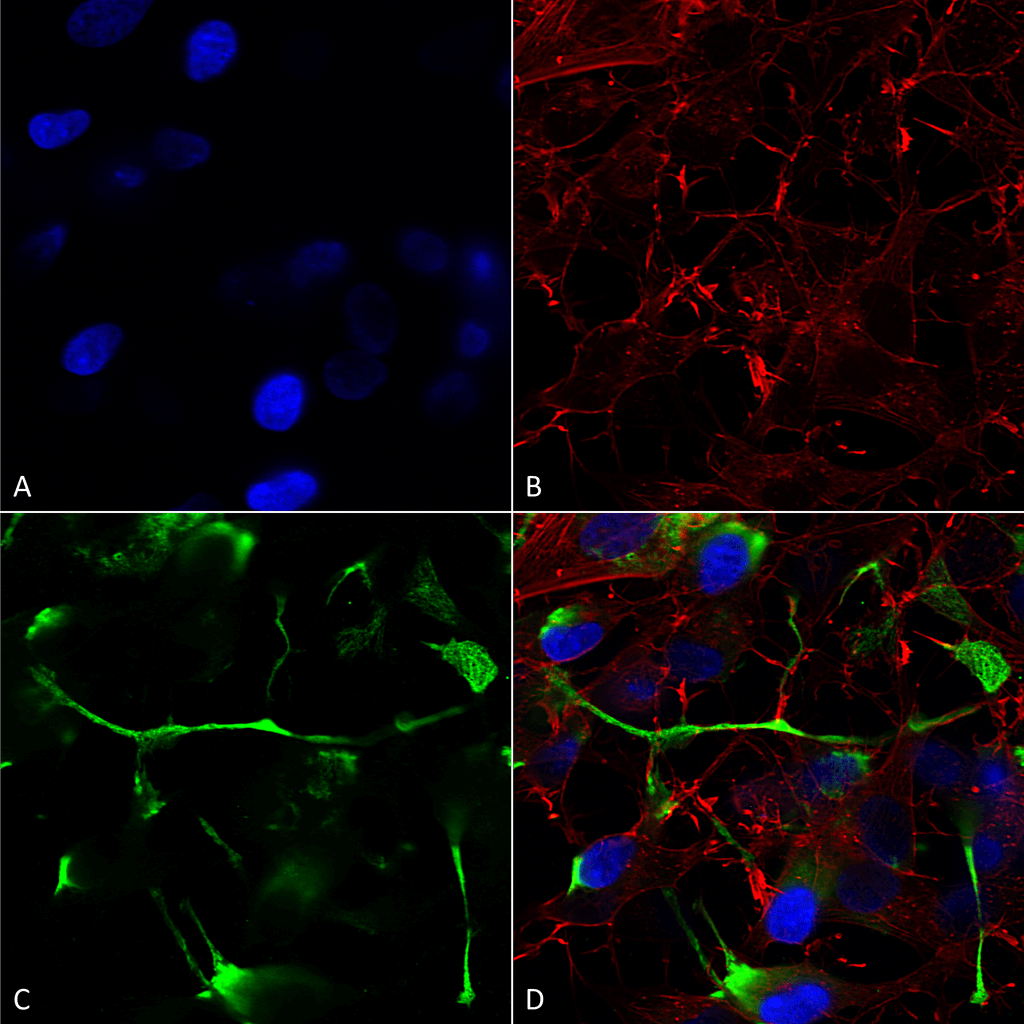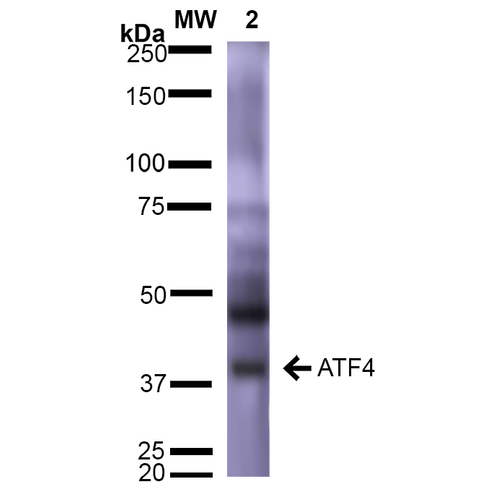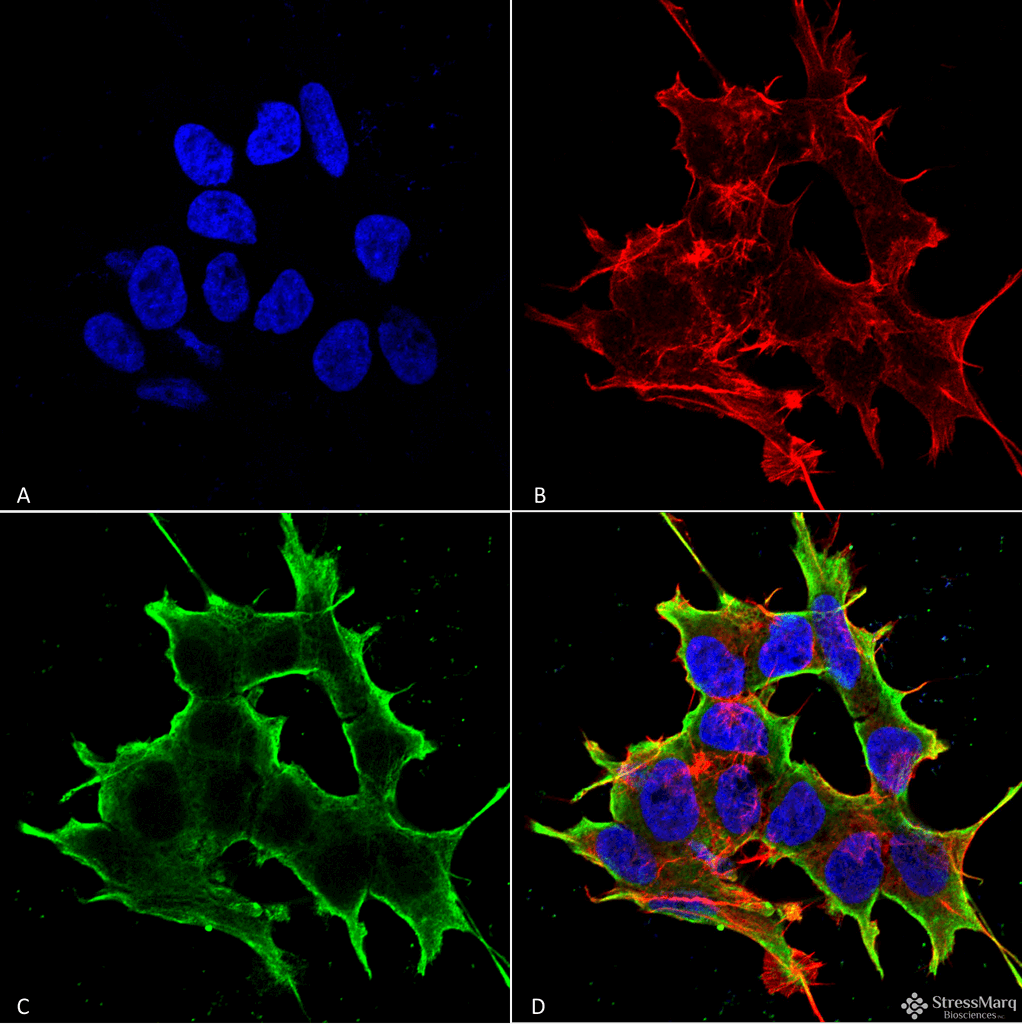Anti-Activating Transcription Factor 4 (ATF4) Antibody (56583)
Anti-Activating Transcription Factor 4 (ATF4) Antibody (56583)
Product No.: 56583
- -
- -
Clone N360A/24 Target Activating Transcription Factor 4 (ATF4) Formats AvailableView All Product Type Monoclonal Alternate Names cAMP-dependent transcription factor ATF-4, Activating transcription factor 4, Cyclic AMP-responsive element-binding protein 2, CREB-2, cAMP-responsive element-binding protein 2, Tax-responsive enhancer element-binding protein 67, TaxREB67 Isotype Mouse IgG2a Applications ICC , IF , IHC , WB |
Data
 Immunocytochemistry/Immunofluorescence analysis using Mouse Anti-ATF4 Monoclonal Antibody, Clone S360A-24 (56583). Tissue: Neuroblastoma cells (SH-SY5Y). Species: Human. Fixation: 4% PFA for 15 min. Primary Antibody: Mouse Anti-ATF4 Monoclonal Antibody (56583) at 1:200 for overnight at 4°C with slow rocking. Secondary Antibody: AlexaFluor 488 at 1:1000 for 1 hour at RT. Counterstain: Phalloidin-iFluor 647 (red) F-Actin stain; Hoechst (blue) nuclear stain at 1:800, 1.6mM for 20 min at RT. (A) Hoechst (blue) nuclear stain. (B) Phalloidin-iFluor 647 (red) F-Actin stain. (C) ATF4 Antibody (D) Composite.
Immunocytochemistry/Immunofluorescence analysis using Mouse Anti-ATF4 Monoclonal Antibody, Clone S360A-24 (56583). Tissue: Neuroblastoma cells (SH-SY5Y). Species: Human. Fixation: 4% PFA for 15 min. Primary Antibody: Mouse Anti-ATF4 Monoclonal Antibody (56583) at 1:200 for overnight at 4°C with slow rocking. Secondary Antibody: AlexaFluor 488 at 1:1000 for 1 hour at RT. Counterstain: Phalloidin-iFluor 647 (red) F-Actin stain; Hoechst (blue) nuclear stain at 1:800, 1.6mM for 20 min at RT. (A) Hoechst (blue) nuclear stain. (B) Phalloidin-iFluor 647 (red) F-Actin stain. (C) ATF4 Antibody (D) Composite. Western Blot analysis of Rat Brain showing detection of ~39 kDa (isoform 2) ATF4 protein using Mouse Anti-ATF4 Monoclonal Antibody, Clone N360A/24 (56583). Lane 1: Molecular Weight Ladder (MW). Lane 2: Rat Brain. Load: 15 µg. Block: 5% Skim Milk in 1X TBST. Primary Antibody: Mouse Anti-ATF4 Monoclonal Antibody (56583) at 1:1000 for 2 hours at RT. Secondary Antibody: Goat Anti-Mouse IgG: HRP at 1:2000 for 60 min at RT. Color Development: ECL solution for 5 min at RT. Predicted/Observed Size: ~39 kDa (isoform 2).
Western Blot analysis of Rat Brain showing detection of ~39 kDa (isoform 2) ATF4 protein using Mouse Anti-ATF4 Monoclonal Antibody, Clone N360A/24 (56583). Lane 1: Molecular Weight Ladder (MW). Lane 2: Rat Brain. Load: 15 µg. Block: 5% Skim Milk in 1X TBST. Primary Antibody: Mouse Anti-ATF4 Monoclonal Antibody (56583) at 1:1000 for 2 hours at RT. Secondary Antibody: Goat Anti-Mouse IgG: HRP at 1:2000 for 60 min at RT. Color Development: ECL solution for 5 min at RT. Predicted/Observed Size: ~39 kDa (isoform 2). Immunocytochemistry/Immunofluorescence analysis using Mouse Anti-ATF4 Monoclonal Antibody, Clone S360A-24 (56583). Tissue: Neuroblastoma cell line (SK-N-BE). Species: Human. Fixation: 4% Formaldehyde for 15 min at RT. Primary Antibody: Mouse Anti-ATF4 Monoclonal Antibody (56583) at 1:100 for 60 min at RT. Secondary Antibody: Goat Anti-Mouse ATTO 488 at 1:100 for 60 min at RT. Counterstain: Phalloidin Texas Red F-Actin stain; DAPI (blue) nuclear stain at 1:1000; 1:5000 for 60 min RT, 5 min RT. Localization: Cytoplasm, Cell Membrane. Magnification: 60X. (A) DAPI (blue) nuclear stain. (B) Phalloidin Texas Red F-Actin stain. (C) ATF4 Antibody. (D) Composite.
Immunocytochemistry/Immunofluorescence analysis using Mouse Anti-ATF4 Monoclonal Antibody, Clone S360A-24 (56583). Tissue: Neuroblastoma cell line (SK-N-BE). Species: Human. Fixation: 4% Formaldehyde for 15 min at RT. Primary Antibody: Mouse Anti-ATF4 Monoclonal Antibody (56583) at 1:100 for 60 min at RT. Secondary Antibody: Goat Anti-Mouse ATTO 488 at 1:100 for 60 min at RT. Counterstain: Phalloidin Texas Red F-Actin stain; DAPI (blue) nuclear stain at 1:1000; 1:5000 for 60 min RT, 5 min RT. Localization: Cytoplasm, Cell Membrane. Magnification: 60X. (A) DAPI (blue) nuclear stain. (B) Phalloidin Texas Red F-Actin stain. (C) ATF4 Antibody. (D) Composite. - -
- -
Antibody DetailsProduct DetailsReactivity Species Human ⋅ Rat Host Species Mouse Immunogen Fusion protein corresponding to aa 25-327 of human ATF4. This sequence is 86% identical in rat, 85% identical in mouse, and <50% identical in ATF5. Product Concentration 1.0 mg/ml Formulation PBS, pH 7.4, 0.1% sodium azide, 50% glycerol. State of Matter Liquid Product Preparation Purified by Protein G affinity chromatography Storage and Handling This product is stable for at least one (1) year at -20°C. Country of Origin USA Shipping Next Day 2-8°C Applications and Recommended Usage? Quality Tested by Leinco Immunoblotting: use at 1-5ug/mL. A band of ~60kDa is detected.
Immunofluorescence: use at 10ug/mL.Detection of ATF4 in rat brain lysate with #56583. These are recommended concentrations. Endusers should determine optimal concentrations for their application. Each investigator should determine their own optimal working dilution for specific applications. See directions on lot specific datasheets, as information may periodically change. DescriptionSpecificity Mouse Monoclonal Antibody specific to Human and Rat Activating Transcription Factor 4 (ATF4) Background ATF4 belongs to the large ATF/CREB family of transcription factors. These proteins bind DNA via their basic region and dimerize via their leucine zipper domain to form a variety of homo- and heterodimers that regulate gene transcription. Two alternative transcripts encoding the same protein have been described. ATF4 transcription factor is also known to play role in osteoblast differentiation. Terminal osteoblast differentiation, is significantly inhibited by the inactivation of JNK; JNK inactivation downregulates expression of ATF-4. Antigen DetailsFunction Transcription factor that binds the cAMP response element (CRE) (consensus: 5'-GTGACGT[AC][AG]-3') and displays two biological functions, as regulator of metabolic and redox processes under normal cellular conditions, and as master transcription factor during integrated stress response (ISR) (PubMed:17684156, PubMed:16682973, PubMed:31444471, PubMed:32132707). Binds to asymmetric CRE's as a heterodimer and to palindromic CRE's as a homodimer (By similarity). Core effector of the ISR, which is required for adaptation to various stress such as endoplasmic reticulum (ER) stress, amino acid starvation, mitochondrial stress or oxidative stress (PubMed:32132707). During ISR, ATF4 translation is induced via an alternative ribosome translation re-initiation mechanism in response to EIF2S1/eIF-2-alpha phosphorylation, and stress-induced ATF4 acts as a master transcription factor of stress-responsive genes in order to promote cell rUniProtKB:Q06507, PubMed:11960987, PubMed:15109498, PubMed:15775988, PubMed:16682973, PubMed:17684156, PubMed:18940792, PubMed:26086088, PubMed:31444471, PubMed:32132706, PubMed:32132707, PubMed:33384352}.; (Microbial infection) Binds to a Tax-responsive enhancer element in the long terminal repeat of HTLV-I. {PubMed:1847461}. NCBI Gene Bank ID UniProt.org Research Area Neuroscience References & CitationsTechnical Protocols |


